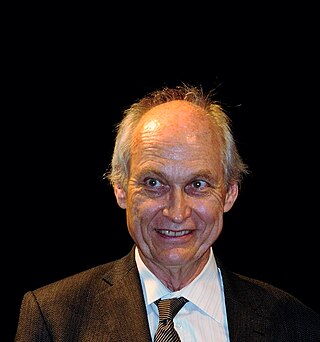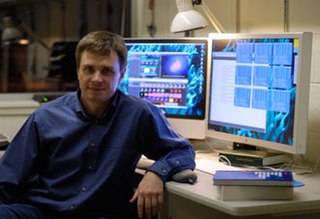
Michael S. Turner is an American theoretical cosmologist who coined the term dark energy in 1998. He is the Rauner Distinguished Service Professor Emeritus of Physics at the University of Chicago, having previously served as the Bruce V. & Diana M. Rauner Distinguished Service Professor, and as the assistant director for Mathematical and Physical Sciences for the US National Science Foundation.

The Smithsonian Astrophysical Observatory (SAO) is a research institute of the Smithsonian Institution, concentrating on astrophysical studies including galactic and extragalactic astronomy, cosmology, solar, earth and planetary sciences, theory and instrumentation, using observations at wavelengths from the highest energy gamma rays to the radio, along with gravitational waves. Established in Washington, D.C., in 1890, the SAO moved its headquarters in 1955 to Cambridge, Massachusetts, where its research is a collaboration with the Harvard College Observatory (HCO) and the Harvard University Department of Astronomy. In 1973, the Smithsonian and Harvard formalized the collaboration as the Center for Astrophysics | Harvard & Smithsonian (CfA) under a single Director.

The Center for Astrophysics | Harvard & Smithsonian (CfA), previously known as the Harvard–Smithsonian Center for Astrophysics, is an astrophysics research institute jointly operated by the Harvard College Observatory and Smithsonian Astrophysical Observatory. Founded in 1973 and headquartered in Cambridge, Massachusetts, United States, the CfA leads a broad program of research in astronomy, astrophysics, Earth and space sciences, as well as science education. The CfA either leads or participates in the development and operations of more than fifteen ground- and space-based astronomical research observatories across the electromagnetic spectrum, including the forthcoming Giant Magellan Telescope (GMT) and the Chandra X-ray Observatory, one of NASA's Great Observatories.

Bryan Malcolm Gaensler is an Australian astronomer based at the University of California, Santa Cruz. He studies magnetars, supernova remnants, and magnetic fields. In 2014, he was appointed as Director of the Dunlap Institute for Astronomy & Astrophysics at the University of Toronto, after James R. Graham's departure. He was the co-chair of the Canadian 2020 Long Range Plan Committee with Pauline Barmby. In 2023, he was appointed as Dean of Physical and Biological Sciences at UC Santa Cruz.

Margaret J. Geller is an American astrophysicist at the Center for Astrophysics | Harvard & Smithsonian. Her work has included pioneering maps of the nearby universe, studies of the relationship between galaxies and their environment, and the development and application of methods for measuring the distribution of matter in the universe.
Amy J. Barger is an American astronomer and Henrietta Leavitt Professor of Astronomy at the University of Wisconsin–Madison. She is considered a pioneer in combining data from multiple telescopes to monitor multiple wavelengths and in discovering distant galaxies and supermassive black holes, which are outside of the visible spectrum. Barger is an active member of the International Astronomical Union.

William Nielsen Brandt is the Verne M. Willaman Professor of Astronomy & Astrophysics and a professor of physics at the Pennsylvania State University. He is best known for his work on active galaxies, cosmological X-ray surveys, starburst galaxies, normal galaxies, and X-ray binaries.
Leon P. Van Speybroeck was an American astronomer who served as Telescope Scientist for the Chandra X-Ray Observatory, which was launched into space aboard the Space Shuttle Columbia in 1999. Van Speybroek designed the mirrors that made possible its spectacular X-ray images of nearby and remote celestial objects, including comets, exploding stars, jets of gas spewing from nearby black holes, and powerful quasars more than 10 billion light years from Earth. The data from Chandra prompted new discoveries about the evolution of stars and galaxies, the nature of the black holes, dark matter, and the shape and dimensions of the universe.

Somak Raychaudhury is an Indian astrophysicist. He is the Vice-Chancellor at Ashoka University and was the Director of the Inter-University Centre for Astronomy and Astrophysics (IUCAA), Pune. He is on leave from Presidency University, Kolkata, India, where he is a Professor of Physics, and is also affiliated to the University of Birmingham, United Kingdom. He is known for his work on stellar mass black holes and supermassive black holes. His significant contributions include those in the fields of gravitational lensing, galaxy dynamics and large-scale motions in the Universe, including the Great Attractor.

Jonathan Christopher McDowell is an astronomer and astrophysicist at the Harvard–Smithsonian Center for Astrophysics. He is a staff member at the Chandra X-ray Observatory. McDowell is the author and editor of Jonathan's Space Report, an e-mail-distributed newsletter documenting satellite launches.

Christine Jones Forman is a senior astrophysicist at the Center for Astrophysics | Harvard & Smithsonian. She is a past president of the American Astronomical Society, and was the director of the Smithsonian Institution's Consortium for Unlocking the Mysteries of the Universe.

Dr. Martin C. Weisskopf until his retirement from NASA in at the end of May, 2022, was project scientist for NASA's Chandra X-ray Observatory and Chief Scientist for X-ray Astronomy in the Space Sciences Department at NASA's Marshall Space Flight Center in Huntsville, Alabama. He was also the Principal Investigator of the Small Explorer mission the Imaging X-ray Polarization Explorer (IXPE).

Vassiliki Kalogera is a Greek astrophysicist. She is a professor at Northwestern University and the director of the Center for Interdisciplinary Exploration and Research in Astrophysics (CIERA). She is a leading member of the LIGO Collaboration that observed gravitational waves in 2015.

Kimberly Kowal Arcand is a data visualizer and science communicator for NASA's Chandra X-ray Observatory. She is also the visualization coordinator for the Aesthetics and Astronomy image response project at the Center for Astrophysics | Harvard & Smithsonian located in Cambridge, Massachusetts.

Rita M. Sambruna Commander OMRI (Hon) is an Italian-American astrophysicist and is the Deputy Director of the Astrophysics Science Division at National Aeronautics and Space Administration's (NASA) Goddard Space Flight Center. From September 2022 to May 2023, she was the Acting Deputy Director of the Science Exploration Directorate at Goddard. Rita held the Clare Boothe Luce Professorship in Physics and Astronomy at George Mason University in 2000-2005.

Anne L. Kinney is an American space scientist and educator. Kinney is currently the Deputy Center Director at NASA Goddard Space Flight Center. Previously, she held positions as the head of the Directorate for Mathematical and Physical Sciences (MPS) for the National Science Foundation (NSF), the Chief Scientist of the W.M. Keck Observatory, Director of the Solar System Exploration Division at NASA Goddard Space Flight Center, Director of the Origins Program at NASA Jet Propulsion Laboratory, and Director of the Universe Division at NASA Headquarters. She earned a bachelor's degree in astronomy and physics from the University of Wisconsin-Madison and a doctorate in astrophysics from New York University, and has published more than 80 papers on extragalactic astronomy. She was an instrument scientist for the Faint Object Spectrograph that flew on the Hubble Space Telescope.

Alexey Vikhlinin is a Russian-American astrophysicist notable for achievements in the astrophysics of high energy phenomenon, namely galaxy cluster cosmology and the design of space-based X-ray observatories. He is currently a senior astrophysicist at the Smithsonian Astrophysical Observatory, part of the Center for Astrophysics | Harvard & Smithsonian in Cambridge, Massachusetts. He was recently the Science and Technology Definition Team (STDT) Community Co-Chair for the Lynx X-ray Observatory, a NASA-funded Large Mission Concept Study under consideration by the 2020 Decadal Survey on Astronomy and Astrophysics.

Dara J. Norman is an astronomer and the deputy director of the Community Science and Data Center at the National Science Foundation's National Optical-Infrared Astronomy Research Laboratory (NOIRLab) in Tucson, Arizona. She is also the Association of Universities for Research in Astronomy Diversity Advocate at NOAO. Her research centers on the influence of Active Galactic Nuclei (AGN) on the evolution of galaxies. In 2020, she was inducted into the inaugural cohort of American Astronomical Society Fellows in recognition of her leadership and achievements.
Aneta Siemiginowska is a Polish-American astrophysicist whose research involves high-energy cosmic objects including supermassive black hole, quasars, blazars, active galaxies, and astrophysical jets. She works at the Center for Astrophysics | Harvard & Smithsonian as a senior astrophysicist in the Chandra X-ray Center.

Grant Tremblay is an American astrophysicist notable for research on supermassive black holes, science communication, and public advocacy for large space telescopes. He is currently an Astrophysicist at the Harvard-Smithsonian Center for Astrophysics, and was formerly a NASA Einstein Fellow at Yale University, a Fellow at the European Southern Observatory (ESO), and an Astronomer at ESO's Very Large Telescope (VLT).
















